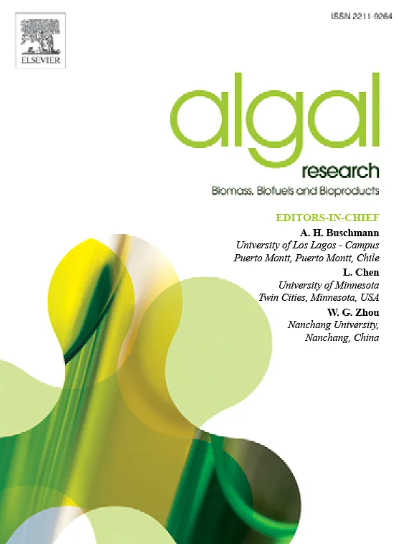Carbon dioxide-assisted enhancement of microalgae growth and pollutant removal in piggery wastewater by newly-isolated ammonia-tolerant microalgae Chlorella sorokinfana
IF 4.5
2区 生物学
Q1 BIOTECHNOLOGY & APPLIED MICROBIOLOGY
Algal Research-Biomass Biofuels and Bioproducts
Pub Date : 2025-05-10
DOI:10.1016/j.algal.2025.104094
引用次数: 0
Abstract
Livestock and poultry breeding produces a large amount of carbon dioxide (CO2) and wastewater with high concentrations of ammonia‑nitrogen (NH3−N), such as piggery wastewater (PW). Whether CO2 can promote microalgae growth and pollutant removal is promising in the green and sustainable treatment of PW. Thus, this study isolated an ammonia-tolerance microalgae species from the PW, which was used to find optimal CO2 aeration concentration in the microalgae-based PW treatment. The isolated species was identified as Chlorella sorokinfana (genetic similarity of 100 %). The optimal 20 % CO2 addition could provide carbon sources and balance pH, when compared with the control group within nine days, the growth rate and chlorophyll a of the isolated microalgae reached 6.00 × 107 cells/mL/d and 8.79 mg/L, which considerably increased by 113 % and 79 %, respectively (p < 0.05); the removal efficiencies of chemical oxygen demand, dissolved organics, total nitrogen, NH3-N, and total phosphorous were significantly increased from 42 %, 80 %, 23 %, 28 %, and 34 % to 70 %, 88 %, 66 %, 72 %, and 99 %, respectively (p < 0.05). Differential expression genes were also the highest in the 20 % CO2 vs the control groups. Based on the enrichment analysis, 20 % CO2 aeration upregulated ribosome biogenesis and nitrogen metabolism, thus promoting microalgae growth and protein synthesis.

新分离的耐氨微藻小球藻对猪舍废水中微藻生长和污染物去除的二氧化碳辅助作用
畜禽养殖产生大量二氧化碳(CO2)和高浓度氨氮(NH3 - N)废水,如养猪场废水(PW)。CO2是否能促进微藻生长和污染物去除,在PW的绿色可持续处理中具有广阔的应用前景。因此,本研究从PW中分离出一种耐氨微藻,用于寻找微藻基PW处理的最佳CO2曝气浓度。分离种鉴定为小球藻sorokinfana(遗传相似性为100%)。当CO2添加量为20%时,可提供碳源和平衡pH,与对照组相比,9 d内分离出的微藻生长速率和叶绿素a分别达到6.00 × 107个细胞/mL/d和8.79 mg/L,分别显著提高了113%和79% (p <;0.05);化学需氧量、溶解有机物、总氮、NH3-N和总磷的去除率分别从42%、80%、23%、28%和34%显著提高到70%、88%、66%、72%和99% (p <;0.05)。与对照组相比,20% CO2组的差异表达基因也是最高的。富集分析表明,20% CO2曝气可上调核糖体生物发生和氮代谢,从而促进微藻生长和蛋白质合成。
本文章由计算机程序翻译,如有差异,请以英文原文为准。
求助全文
约1分钟内获得全文
求助全文
来源期刊

Algal Research-Biomass Biofuels and Bioproducts
BIOTECHNOLOGY & APPLIED MICROBIOLOGY-
CiteScore
9.40
自引率
7.80%
发文量
332
期刊介绍:
Algal Research is an international phycology journal covering all areas of emerging technologies in algae biology, biomass production, cultivation, harvesting, extraction, bioproducts, biorefinery, engineering, and econometrics. Algae is defined to include cyanobacteria, microalgae, and protists and symbionts of interest in biotechnology. The journal publishes original research and reviews for the following scope: algal biology, including but not exclusive to: phylogeny, biodiversity, molecular traits, metabolic regulation, and genetic engineering, algal cultivation, e.g. phototrophic systems, heterotrophic systems, and mixotrophic systems, algal harvesting and extraction systems, biotechnology to convert algal biomass and components into biofuels and bioproducts, e.g., nutraceuticals, pharmaceuticals, animal feed, plastics, etc. algal products and their economic assessment
 求助内容:
求助内容: 应助结果提醒方式:
应助结果提醒方式:


